A wonderfully tender, crisp homemade tart crust is easier to make than you think! The dough comes together in a matter of minutes, and all that’s left is to chill it, roll it out, and bake it until it is golden brown. So simple!
My tart crust recipe is a variation of a pâte sucrée, which is typically made with confectioners’ sugar. You can swap the granulated sugar in this recipe for powdered sugar with a few changes that I outlined further down if you want to make a more traditional dough. To bake more French pastry recipes, try my homemade eclairs, macarons, and canelés.
What You Need To Make This Recipe
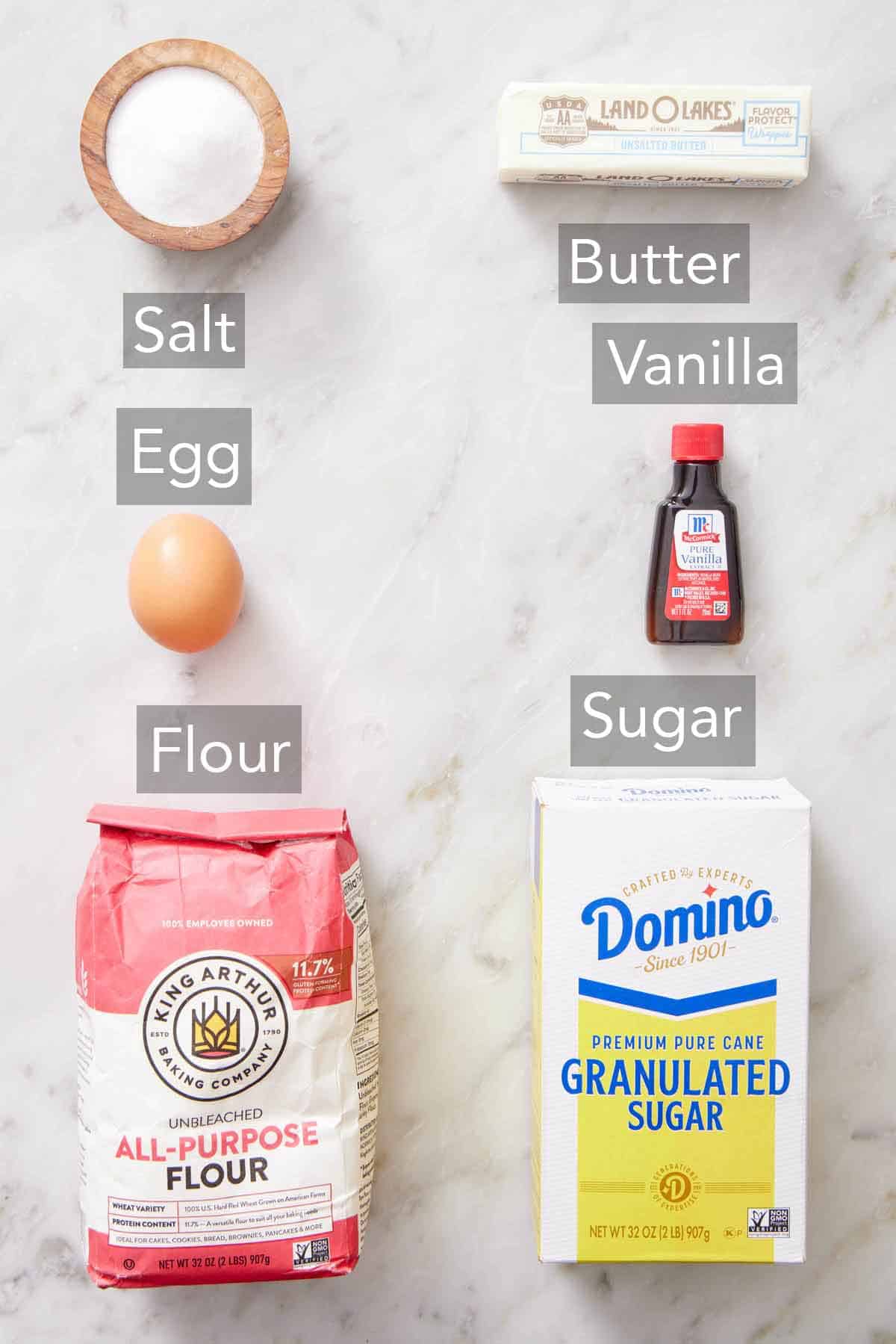
Flour — you need all-purpose flour for the sweet tart crust.
Sugar — granulated sugar adds just the right amount of sweetness without making the crust too sweet and contributes to the crust developing a golden exterior and crisp texture.
Salt — salt rounds out the flavor.
Butter — you need cold butter for this recipe. Opt for unsalted butter so the crust doesn’t turn out salty.
Egg — an egg helps tenderize the dough so the crust doesn’t turn out tough.
Vanilla — a splash of vanilla extract adds a little flavor to the tart crust.
What’s The Difference Between Pie Dough And Tart Dough?
One key difference is that a pie crust is lighter and flaky, whereas a tart crust is tender and dense but crisp (almost like a shortbread cookie). When making pie dough, you need large chunks of butter throughout the dough that melt when baking and form a light, flaky crust. In this tart crust recipe, you’ll work the butter into the dough fully using the sablage method, with no large pieces of butter left behind.
Why You Should Full Incorporate The Butter
While this recipe is not technically a pâte sablée, I love using the sablage method for a super tender tart dough. This simple French technique involves rubbing cold butter into the flour and other dry ingredients before adding the egg. Coating the flour with fat helps to “protect” the flour from the liquid ingredients, which also helps to slow gluten formation as you mix and shape the dough. The dough mixture will have a coarse, sandy texture, hence the term sablage. (Sablé is French for sand.)
Another common French baking technique used to make a tart crust is crémage or creaming, where soft butter and sugar are mixed together until fluffy, with flour added afterward. If you’d like to try this method instead for this recipe, I’ve included it in the Pro Tips section for you.
How To Make A Tart Crust
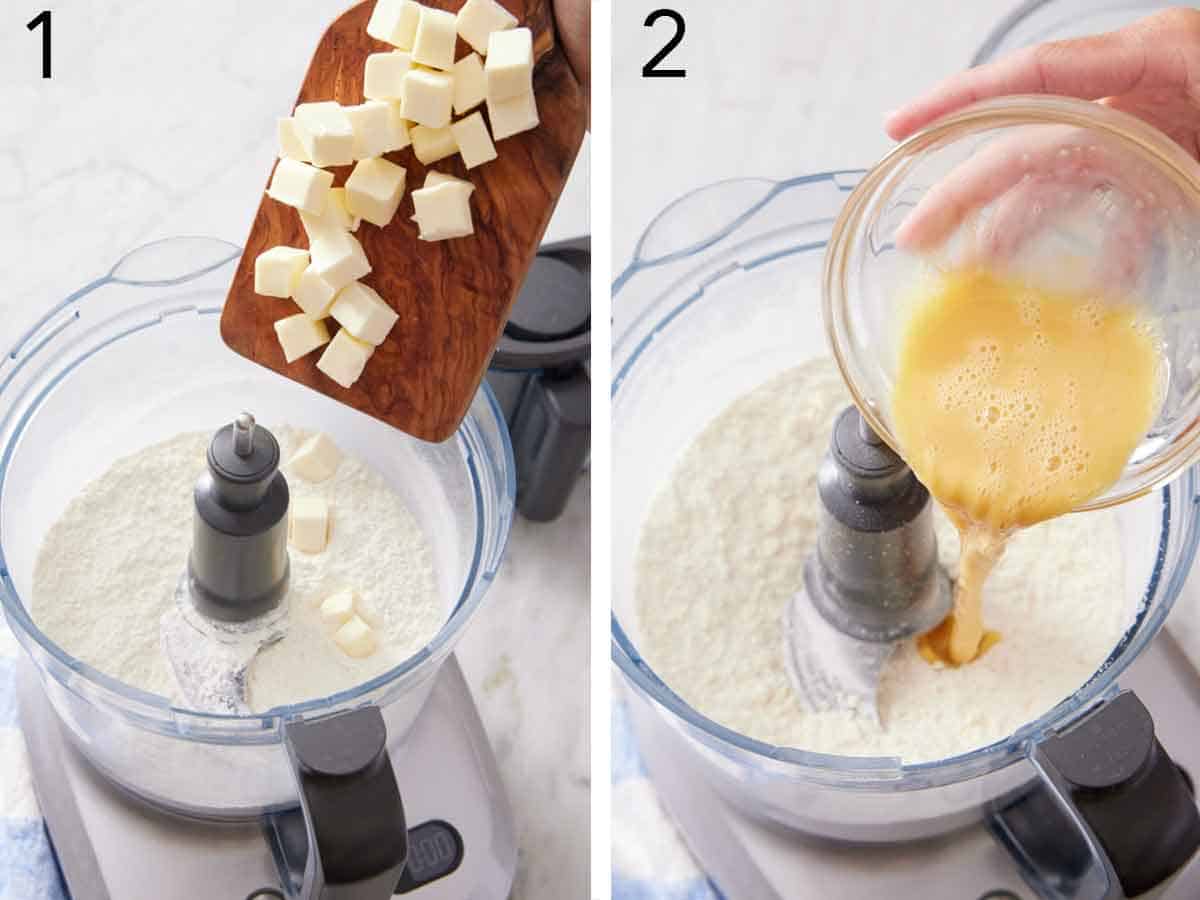
1. You can make this tart dough recipe using a food processor or by hand. The images below demonstrate the food processor method, but I give detailed instructions for mixing the tart crust dough by hand in the recipe card. In the bowl of a food processor, pulse to combine the flour, sugar, and salt. Add the cold diced butter and pulse 8 to 10 times until the butter is broken down into pea-sized pieces.
2. In a small bowl, whisk the egg and vanilla extract until well combined. Add the egg mixture to the flour mixture.
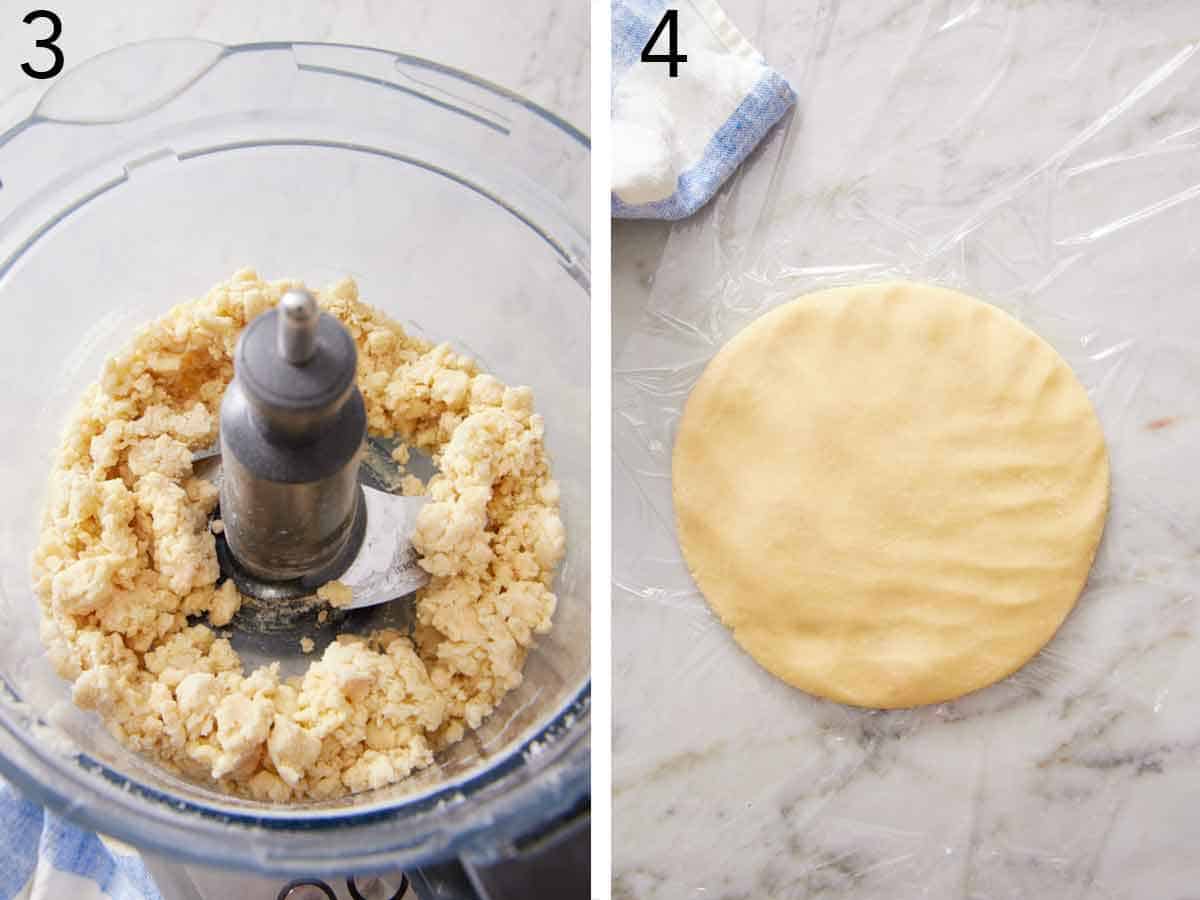
3. Process for about 5 seconds until the mixture resembles coarse breadcrumbs.
4. Turn the dough out onto a floured surface. Knead 3 to 5 times to form it into a cohesive ball. Flatten the dough into a disc shape that’s about 1 inch thick, and wrap it with plastic wrap. Refrigerate the tart crust dough for 1 hour or freeze for 30 minutes.
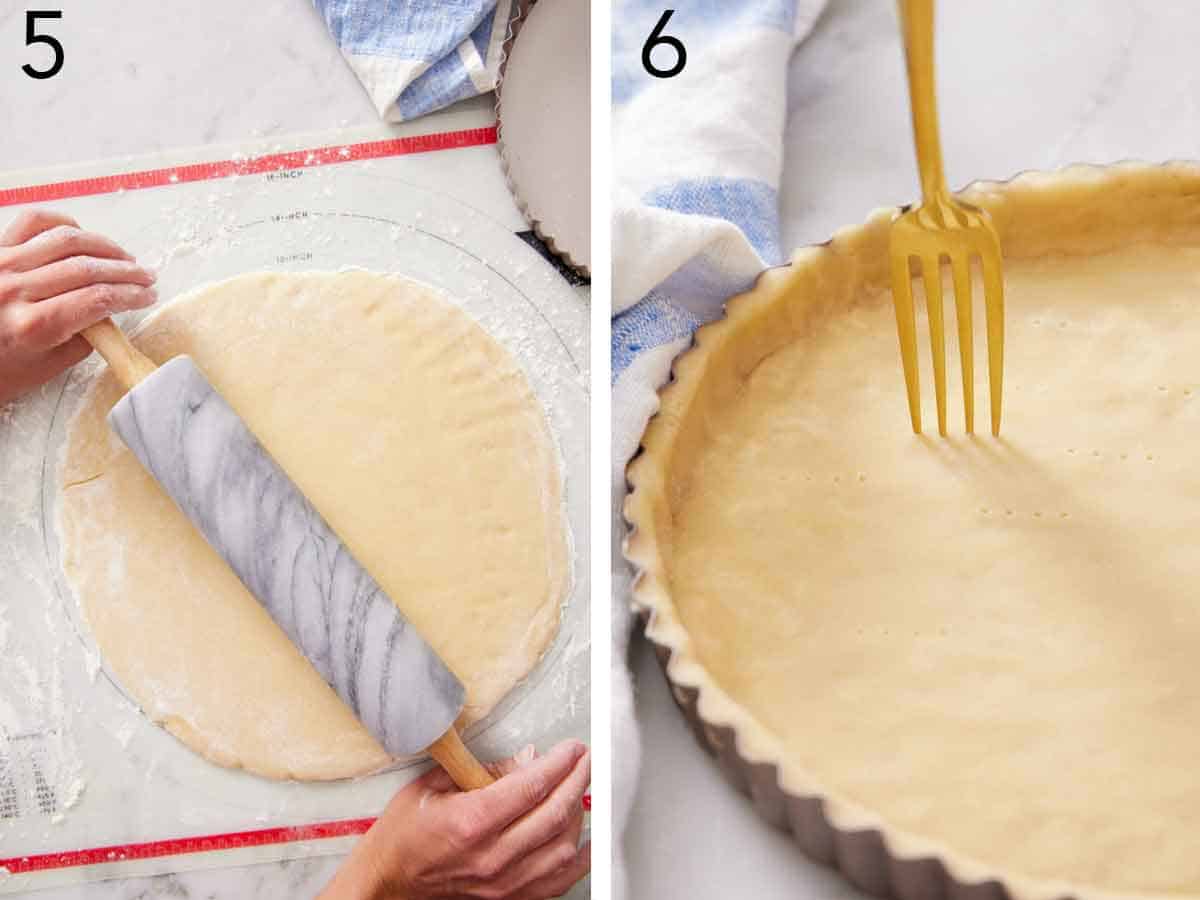
5. Place the chilled dough on a well-floured surface and sprinkle flour over the top. Roll the crust into an 11-inch circle with a rolling pin. Fold the pastry dough into quarters, place it in a 9-inch or 10-inch tart pan, and open it up, centering it in the pan. Press the crust into the corners and sides of the pan. Trim any excess dough overhang at the top rim of the pan. Refrigerate the crust once more for 1 hour or freeze it for 30 minutes.
6. Prick the bottom of the chilled crust 8 to 10 times with a fork. Line the crust with parchment paper and fill with pie weights to prepare for blind baking. To parbake the crust, bake it at 375°F for 12 minutes. Then remove the pie weights and bake it for another 8 to 10 minutes, until the crust looks dry and light golden. To fully bake the crust, follow the baking instructions above, but after removing the baking beans or pie weights, bake for another 14 to 16 minutes until golden brown. Cool completely before filling.

What’s The Best Tart Pan To Use?
A nonstick fluted tart pan with a removable bottom is ideal. You can use this tart crust recipe for a 9-inch or 10-inch round tart pan, a 9-inch square tart pan, or a rectangular tart pan no larger than 14×5 inches. For a square or rectangle, roll the dough into a rectangle 1 inch larger than the dimensions of the tart pan you plan to use.
Can I Make Mini Tart Crusts?
Yes, you can absolutely use this recipe to make mini tarts! Roll out the dough and cut it into circles about 1 inch larger than the diameter of your mini tart pans or molds. Press, trim, and bake the crust as directed. Keep in mind that the bake time will be much less, depending on the size of the mini tart pans. Watch for the crust to turn golden brown when checking for doneness.
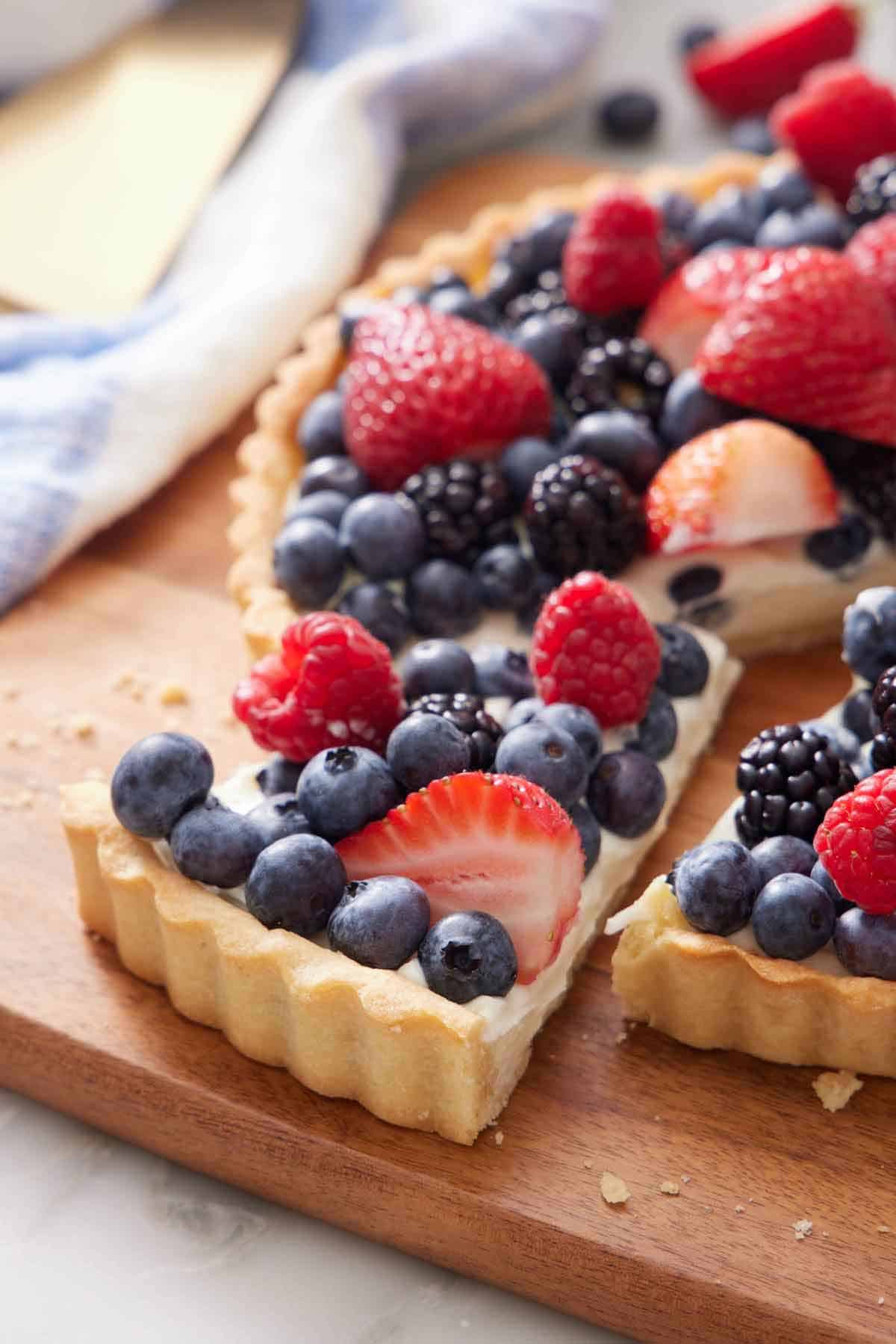
Ways To Use A Tart Crust
- Fill the crust with vanilla pastry cream and fresh berries for one of my favorite no-bake fillings. You can also refer to my fruit tart recipe for other fresh fruit ideas, like sliced peaches and kiwis.
- Fill it with chocolate ganache or lemon curd for another delicious no-bake filling. After smoothing the ganache or curd into the tart crust, refrigerate the tart for about an hour to set.
- Use it as the base for my apple tart, lemon tart, and strawberry tart.
How To Make Ahead
There are a few ways to make this tart crust ahead of time. After wrapping the disc of dough in plastic wrap, you can refrigerate it for up to 3 days. If it is too hard to roll out immediately without cracking, let it sit at room temperature for about 10 minutes to warm up slightly.
You can also shape the crust in the pan and freeze it tightly wrapped in plastic wrap and aluminum foil before baking. It will keep for 3 months in the freezer. Bake the tart crust from frozen.
Store a fully baked tart crust in the baking pan, covered, at room temperature for up to 2 days. It will also freeze well for up to 3 months. Wrap it in plastic wrap and aluminum foil to protect it from freezer burn.
Pro Tips For Making This Recipe
- Weigh the flour. A kitchen scale is the best and most accurate way to measure flour to avoid using too much (which will yield a very dry dough). If you don’t have a scale, fluff the flour up in its container, spoon it into a measuring cup, and level off the top with a knife.
- Use cold butter. The butter needs to be very cold, so when you mix it with the other ingredients, it’s able to form the proper sand-like texture. I often pop the butter back into the fridge after dicing it (for at least 10 minutes) so it can get cold again.
- Make tart crust or pâte sucrée using the creaming method. First, soften the butter. Add it to the bowl of a stand mixer along with the sugar and beat it with the paddle attachment until fluffy and lightened in color. Add the egg and mix to combine. Then, mix in the flour and salt until the double is very crumbly. Then, continue as written in step 4.
- Use powdered sugar. This sweet tart crust recipe is a version of a pâte sucrée, typically made with confectioners’ sugar. You can substitute ⅓ cup of powdered sugar for the granulated sugar if desired.
- If the dough starts to crack while you’re rolling it out…it might be too cold. Cover it and let it sit for 5-10 minutes, then try rolling it again.
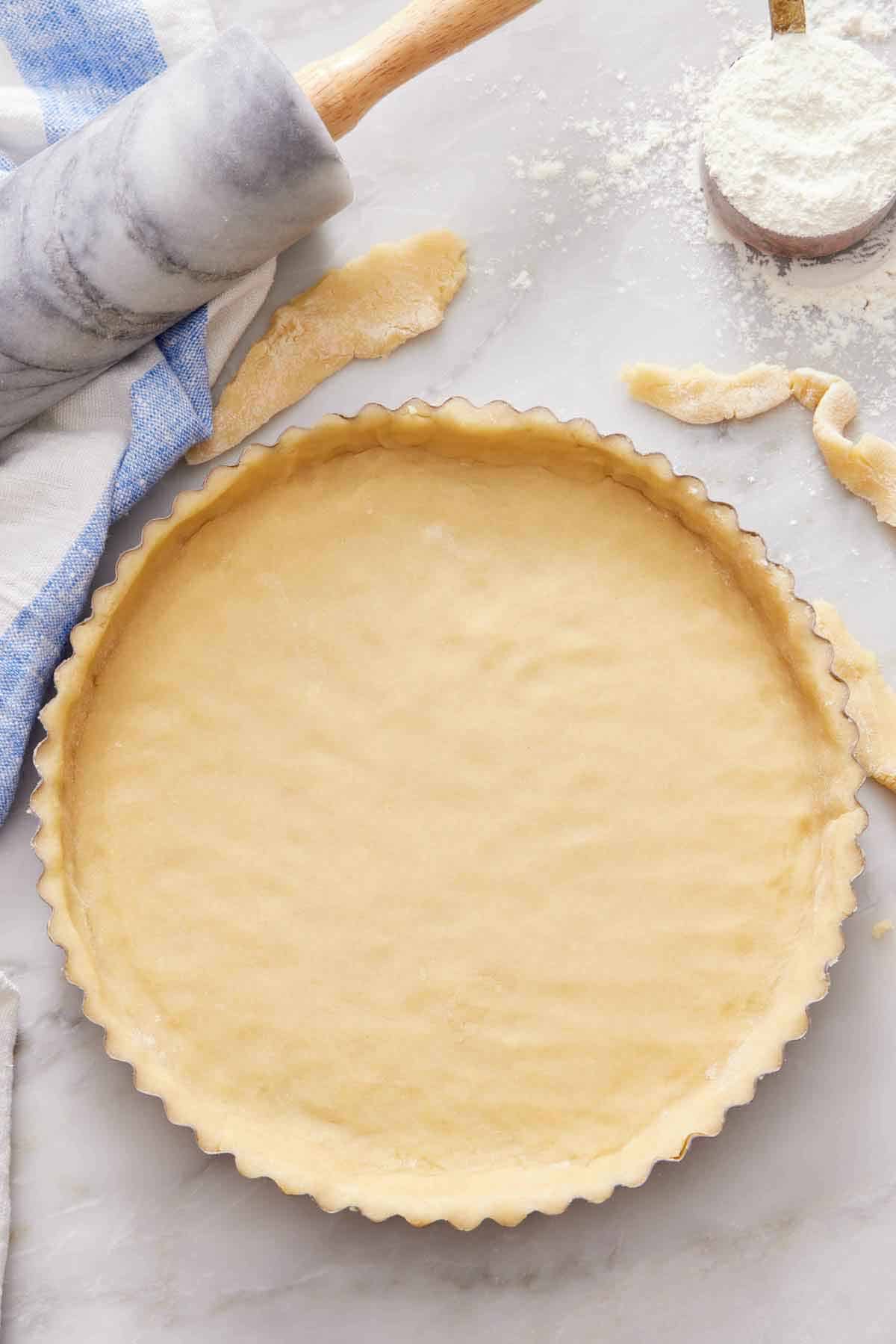
Frequently Asked Questions
You can use a gluten-free all-purpose flour blend that contains xanthan gum. The gluten-free dough mixture might still be too crumbly after adding the egg, which is easily fixed with a tablespoon or two of water.
After wrapping the dough in plastic wrap, you can refrigerate it for up to 3 days or freeze it for up to 3 months. Thaw it overnight in the freezer and let it sit for 10 minutes at room temperature before rolling it out to give it a chance to warm up a tad.
If the pie pan is a shallow metal pan, then yes, it will work. Trim the dough to meet the top edge of the inside of the pan (not the outer rim). But I encourage you to use a tart pan if you can for the best results! You can find them at most stores that have a well-stocked baking pan selection, many craft stores with a cake decorating section, or kitchen suppliers.
If you’ve tried this tart crust recipe, then don’t forget to rate it and let me know how you got on in the comments below. I love hearing from you!
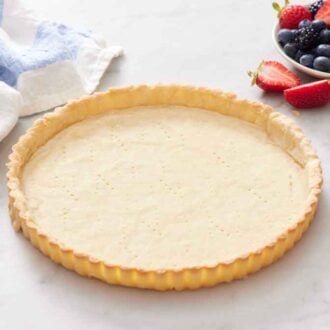
Tart Crust Recipe
Equipment
- Food processor or pastry blender
- 1, 9 or 10-inch tart pan
Ingredients
- 1½ cup all-purpose flour (180g)
- ¼ cup granulated sugar (50g)
- ¼ teaspoon salt
- ½ cup cold unsalted butter diced (57g)
- 1 egg
- ½ teaspoon vanilla extract
Instructions
- Food processor method: In the bowl of a food processor, pulse to combine the flour, sugar and salt. Add the cold butter and pulse 8 to 10 times until the butter is the size of peas. In a small bowl, whisk the egg and vanilla until well combined. Add the egg mixture to the flour mixture and process for about 5 seconds until the mixture resembles coarse breadcrumbs (like panko).
- Mix by hand: In a large mixing bowl, whisk to combine the flour, sugar, and salt. Add the cold butter and cut it into the flour mixture using a pastry blender or by pressing it together with your fingers until it resembles coarse breadcrumbs. In a small bowl, whisk to combine the egg and vanilla. Add it to the flour mixture and stir and knead to combine.
- Turn the dough out onto a floured surface. Knead 3 to 5 times to bring it together into a cohesive ball. Flatten it into a disc shape, about 1 inch thick, and wrap it with plastic wrap. Refrigerate for 1 hour or freeze for 30 minutes.
- To roll-out the crust, place the crust on a well-floured surface and sprinkle flour all over the top. WIth a rolling pin, roll the crust into an 11-inch circle, about ⅛-inch thick. If it starts to crack when rolling, cover it and let it sit for 5 minutes, and try rolling it again.
- Fold the crust into quarters, place it in a 9-inch or 10-inch tart pan, and open it up, centering it in the pan. Press the crust into the corners and sides of the pan. (If the crust cracks or breaks, you can press it back together or press a piece of excess crust into any holes.) Trim any overhang at the top rim of the pan. Refrigerate the crust for 1 hour or freeze it for 30 minutes.
- To parbake: Preheat the oven to 375°F. Prick the bottom of the crust 8 to 10 times with the tines of a fork. Line the crust with parchment paper and fill with pie weights. Bake for 12 minutes. Remove the pie weights and bake another 8 to 10 minutes, until the crust looks dry and light golden.
- To fully bake: Follow the parbake instructions above. After removing the baking beans, cook for 14 to 16 minutes, until the crust is golden brown. Let it cool completely before filling.
Notes
- Weigh the flour. A kitchen scale is the best and most accurate way to measure flour to avoid using too much (which will yield a very dry dough). If you don’t have a scale, fluff the flour up in its container, spoon it into a measuring cup, and level off the top with a knife.
- Use cold butter. The butter needs to be very cold, so when you mix it with the other ingredients, it’s able to form the proper sand-like texture. I often pop the butter back into the fridge after dicing it (for at least 10 minutes) so it can get cold again.
- Make tart crust or pâte sucrée using the creaming method. First, soften the butter. Add it to the bowl of a stand mixer along with the sugar and beat it with the paddle attachment until fluffy and lightened in color. Add the egg and mix to combine. Then, mix in the flour and salt until the double is very crumbly. Then, continue as written in step 4.
- Use powdered sugar. This sweet tart crust recipe is a version of a pâte sucrée, typically made with confectioners’ sugar. You can substitute ⅓ cup of powdered sugar for the granulated sugar if desired.
- If the dough starts to crack while you’re rolling it out…it might be too cold. Cover it and let it sit for 5-10 minutes, then try rolling it again.



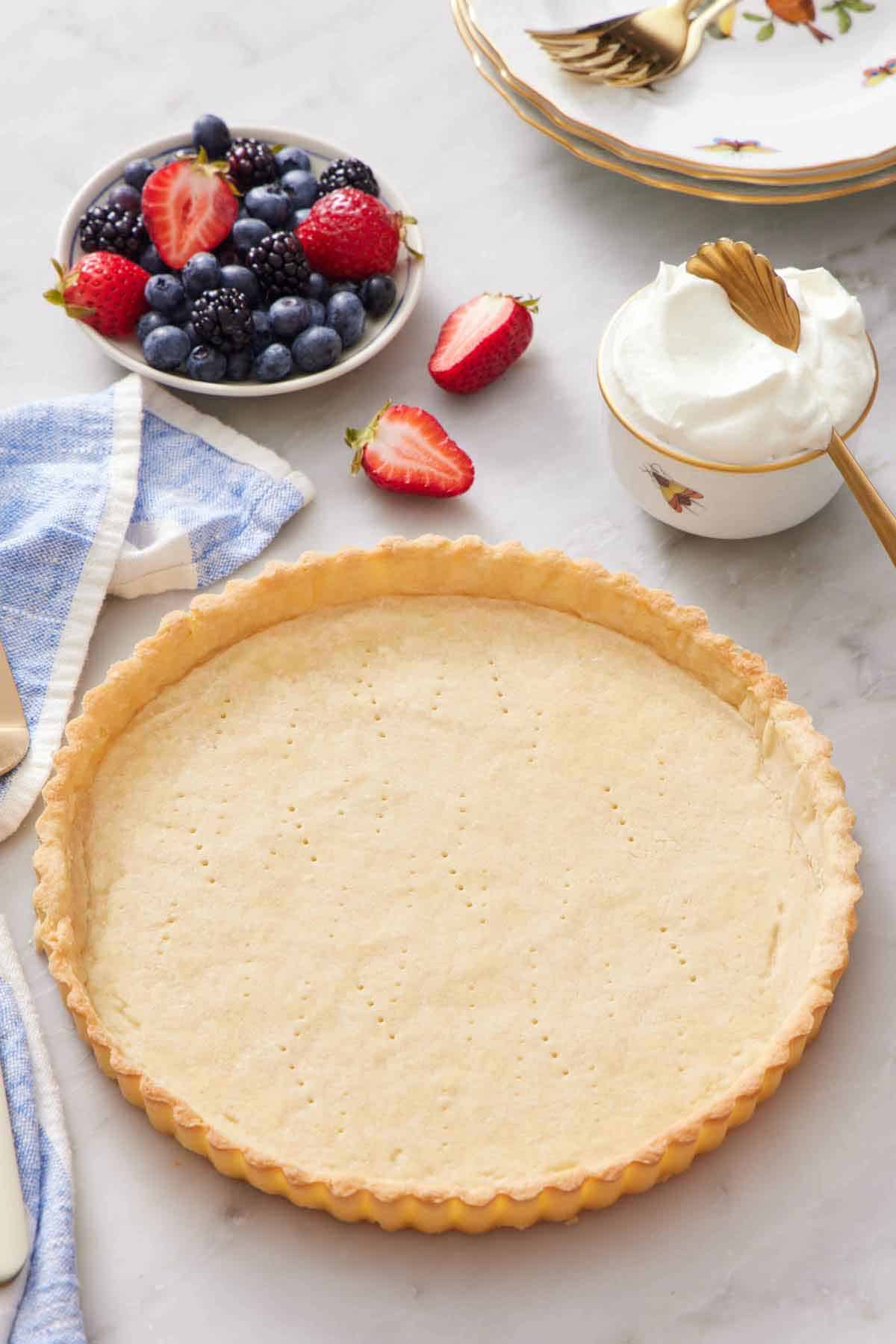


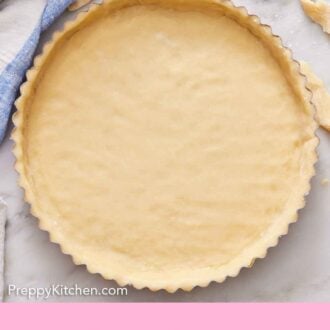
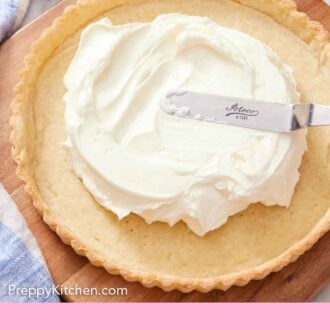
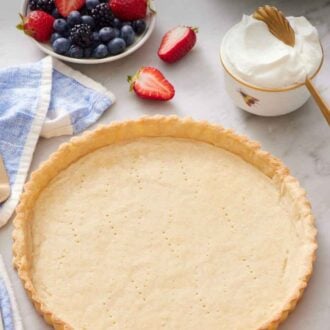

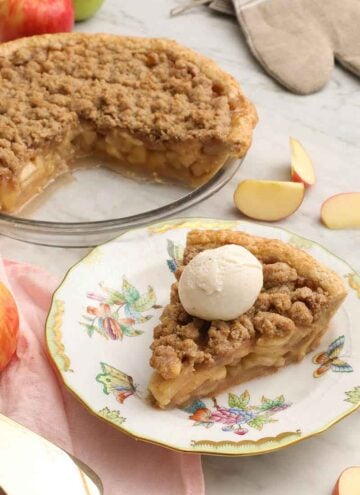
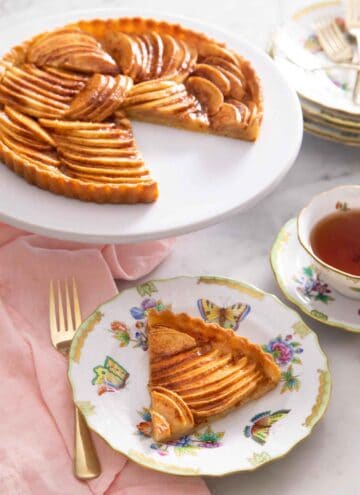
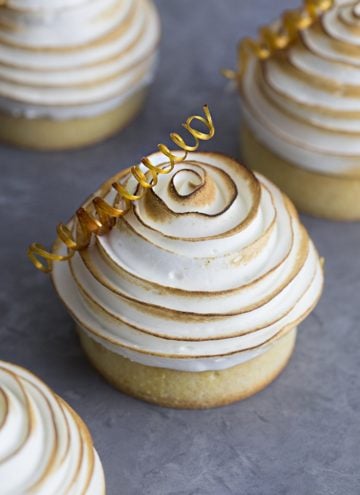
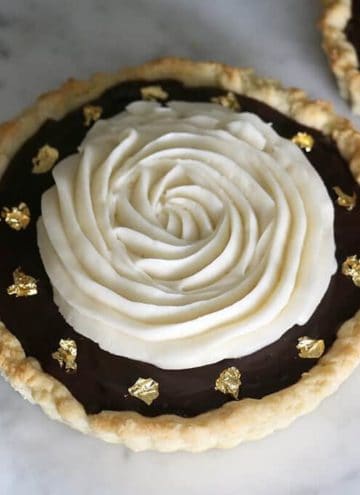

Marta says
Hi:) I’m not an experienced cook but this was simple to make and it turned out amazing! Thank you so much for this great recipe! My family and me loved it:)
Have a nice day!
Kianna Romano says
My go to tart recipe! It’s very simple, tastes delicious, and always the perfect texture. I definitely recommend it! I feel like it could work with different types of desserts, but I use it for my full tarts and mini tartlets:)
Bentley Lin says
Very good